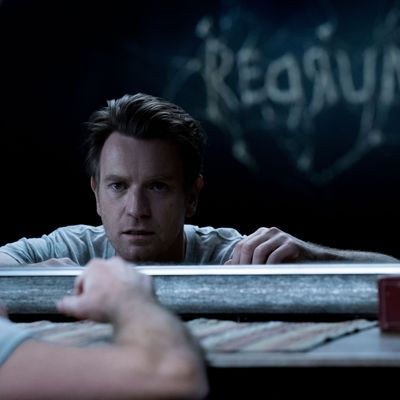
Doctor Sleep is full of indelible imagery — bodies made bloody, an endless hedge maze dappled with snow, a woman gliding across the night sky shot through with stars. And its pleasures don’t end there: A score by the Newton Brothers thumps like an errant heartbeat. The actors sparkle with chemistry. At times, its aesthetic and thematic pursuits click into place and the film sings at a mournful register as it charts the generational trauma and addiction of Dan Torrance (Ewan McGregor). But Doctor Sleep proves stronger in parts than as a whole.
Throughout its 151-minute runtime, there’s the distinct feeling that something is missing from this film, that a slew of miscalculations made it fun to watch but not necessarily profound. Doctor Sleep messily attempts to braid together an adaptation of Stephen King’s novel of the same name while existing on the same cinematic continuum as Stanley Kubrick’s icy and magnificent The Shining. The latter’s outsize legacy inevitably looms large.
Here, Dan Torrance is a haunted man. Not just by the lingering ghosts he encountered at the Overlook Hotel, but by the trauma of his father’s influence — a man he only understands when giving in to darkness and rage. When we meet him, he’s homeless and fiercely alcoholic. He only comes out of this haze after crossing paths with Billy Freeman (Cliff Curtis), who ushers him into Alcoholics Anonymous and a more stable life. But our pasts have a way of catching up with us. When Dan makes a connection to the middle-school age, fellow psychic powerhouse Abra (Kyleigh Curran) — who is being hunted by the cult True Knot, which feeds on people with “shining” powers in a bid for near-immortality — he finds himself returning to the site of his childhood trauma.
Doctor Sleep is perhaps trying to do too much at once. It aims to both broaden and hearken to the world of The Shining; adapt King’s novel and ethos; create a villain with shadowy mythos in the form of Rose the Hat (Rebecca Ferguson), the leader of the True Knot cult; create a quasi-coming-of-age story for Abra; and speak eloquently to the ways childhood traumas mutate into adult vices within Dan’s storyline. The film can never balance all these pursuits. But even though there is a shaggy quality to the way the subplots are sewn together, the film’s initial horror-picture structure makes way for a handful of wondrous sequences helmed by writer, director, and editor Mike Flanagan. Flanagan undoubtedly understands and cares for horror as a genre. His film is light on jump scares, preferring to mount dread with agape doors, ghosts creeping through inky darkness, blood splatters. The best sequences uphold the architecture of the characters’ minds, in which hedge mazes, cathedrals, and darkened childhood bedrooms become battlegrounds for power and control.
Early in the film we’re given a window into how the True Knot cult operates, when they target a young baseball player named Bradley (Jacob Tremblay). They tie him down in a deserted factory lot as he emits cries for help that will never be answered. Rose cuts him first gently, then savagely, because as she says with casual delight, it purifies the “steam” they feed on from psychic children. The cult is feral, even vampiric as they feed. Their eyes glow a phosphorescent blue, limbs intertwining in ecstasy as they ritualistically kill then bury Bradley, while Abra psychically watches what happens in stark terror. It’s this death that turns her character onto the path that leads her to meet Dan as she demonstrates an enviable strength in the face of horror. The moments that center on Rose and her crew render them both creepy and strangely seductive, but the film is at its best when focusing on a more intimate form of horror — the horror of reliving the sins of our parents, and grappling with trauma and addiction along the way. Dan, in particular, is effectively forced to contend with his father’s legacy, whether that be through conversations with the ghost of Dick Hallorann (an excellent Carl Lumbly) or bearing witness to a dead woman and her baby.
Elements of the film’s climax feel a touch silly and overwrought; one scene, in which Dan speaks to the spirit of his father, Jack Torrance (played by Henry Thomas, doing a Jack Nicholson impression), feels distractingly uncanny. Outright recreations of scenes from The Shining, and the flashbacks to a young Danny after his Overlook escape, feel similarly jarring in their familiarity. I imagine your impression of it all will vary depending on your affinity toward Kubrick’s masterwork. Still, much of the pleasure of the film comes from the dynamics between major characters and the ways the new actors bring them to life. Ferguson is living dynamite. Scenes burn with a slinky, sexily malevolent energy whenever she’s onscreen. She’s the best kind of villain — seductive and unnerving in equal measure — who wears athleisure and a top hat (courtesy of costume designer Terry Anderson). Curran is an immediately thrilling presence with a bright, spiky energy that plays off McGregor particularly well. McGregor is appropriately haunted as Dan, feeling the most impactful at the story’s beginning, in moral and emotional gray areas.
But I’m not sure McGregor or Flanagan appropriately answer the questions that flutter just beneath the surface of the film: Is it possible to escape the tragedies our parents handed down to us? How do childhood sorrows mutate and fester into adulthood? Can we ever make peace with our pasts? The film aims in its closing moments to be bittersweet yet hopeful. Instead, it has an unintended, even dour messaging about the cost of escaping your past and whether that’s even possible in life. Doctor Sleep could probably never fully stand on its own, and perhaps it’s not meant to. It’s a horror film with messy pleasures if you’re able to meet it on its own level.


